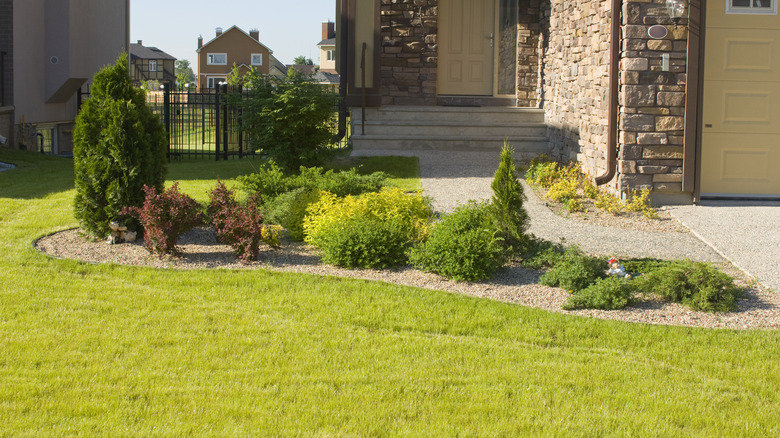Adding Too Much Of This To Your Lawn Will Turn Your Grass Yellow
Maintaining and caring for any lawn can take quite a bit of hard work and patience — and it can be frustrating when, even after all that hard work, your grass is still not that perfect rich green color that you've been going for. You may have already heard of many miracle solutions for turning a lawn from yellowish to deep green. One that is often seen across the internet is adding lime (the rock, not the citrus fruit). While it is true that added lime can make your grass greener in certain situations, before you start adding it to your yard, it is important to know that adding too much can have the opposite effect.
As it turns out, the difference between too much and just enough lime depends entirely on the current pH of your soil. So, before you get started adding lime, you will need to perform a soil test to find out the acidity level of your yard. Most turfgrass species prefer a soil pH level between six and seven. This means that if your soil's pH is below six (on the more acidic side), then adding some lime could make your grass greener. However, if your soil pH is above six, then adding more lime will simply make your soil too alkaline and cause your lawn to turn more yellow.
How lime helps correct acidic soil
Many regions of the United States are more prone to having acidic soil including the East, Southeast, and Pacific Northwest. While having acidic soil isn't necessarily a bad thing (it's great for growing blueberries and rhododendrons), it can make having a beautiful, thick, and green lawn a little difficult. Some signs that your soil is on the acidic side include your yard being sandy or full of clay, your grass being yellow and sparse, your yard being prone to weed and moss growth, and an abundance of oak and pine trees.
If your soil is too acidic for your grass, then adding lime can help. The reason this works so well is that limestone is essentially made of calcium carbonate and magnesium, and as it breaks down in your soil, it releases calcium. According to the GSA, the rise in calcium levels in your soil allows the compounds that cause it to be acidic to bond with the carbonate from the lime and become neutralized. Once this happens, your grass will be able to intake all the nutrients that it was unable to access before and this will cause your lawn to become healthy and green.
Lime isn't a good DIY project
Once you have figured out whether your yard will benefit from lime treatments, you can start looking at how to add it. Unfortunately, adding lime to a lawn is a bit complicated, and unless you have experience, the best method is to hire a lawn care agency to do it for you. The reason for this is that lime needs to be thoroughly mixed into the top few inches of soil to be effective — and this requires special equipment. Furthermore, breathing in lime particles is dangerous and the powder can also burn if it comes into contact with bare skin. Therefore, when applying lime, you should be equipped with proper protective gear, including gloves and a respiratory mask.
While lime can be applied to a lawn any time of year while the ground isn't frozen, the best time to add it to your yard is in the fall because this gives the pellets enough time to break down in the soil and alter the acidity level before your grass comes out of dormancy and starts growing again in the spring.


